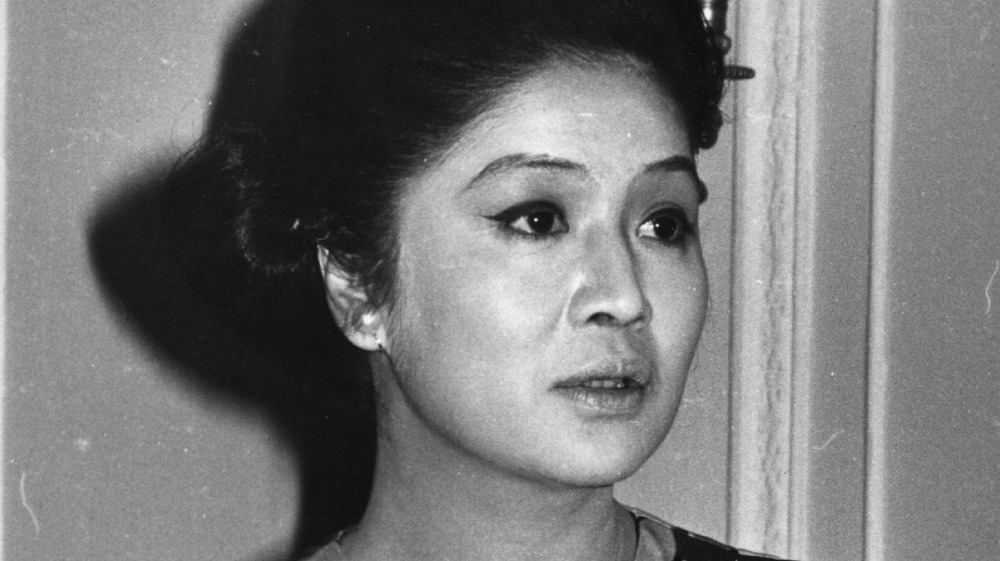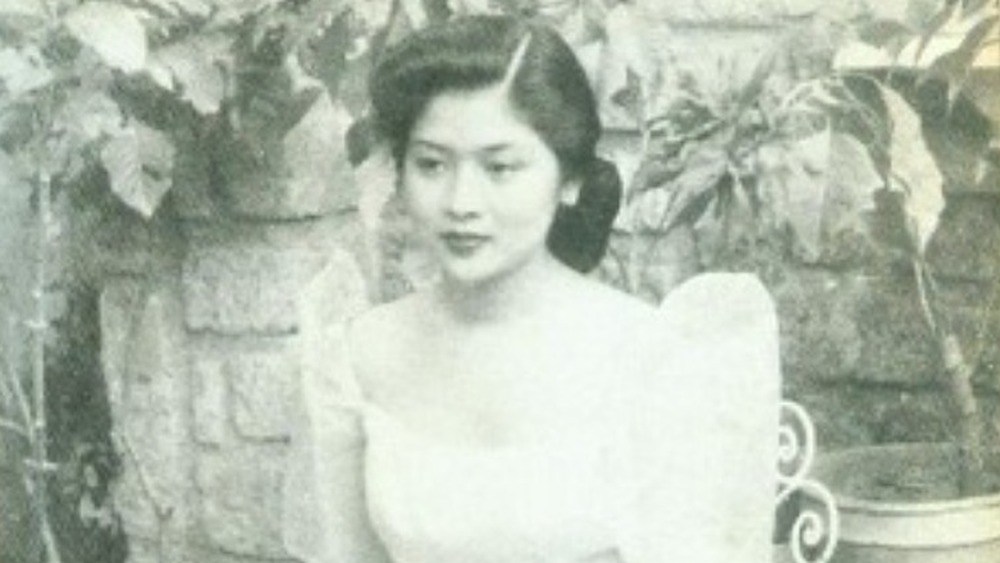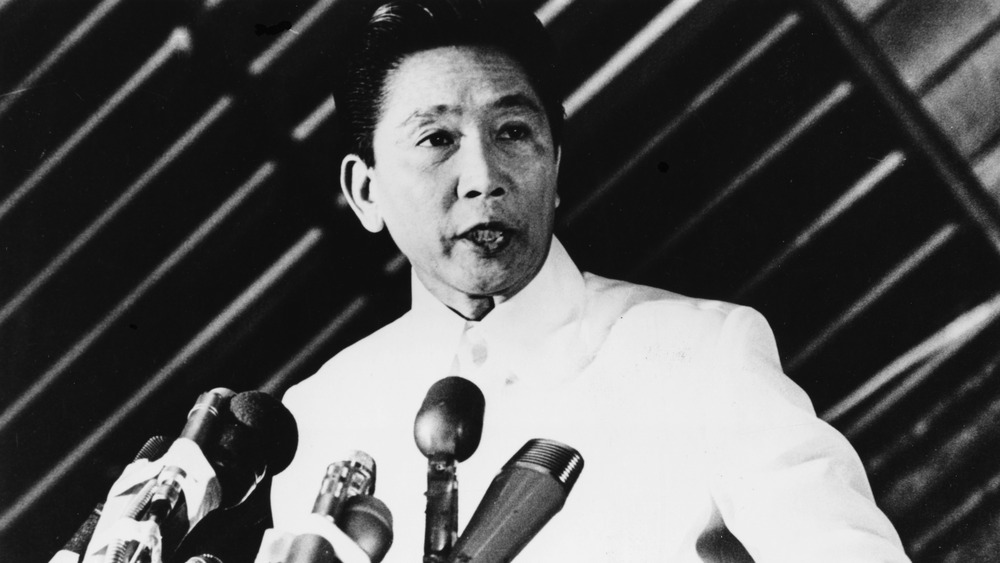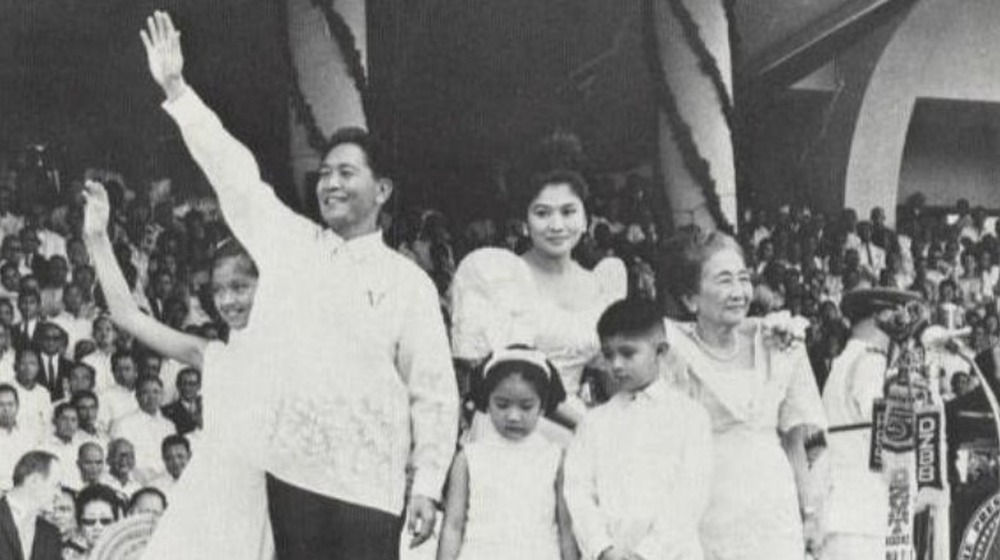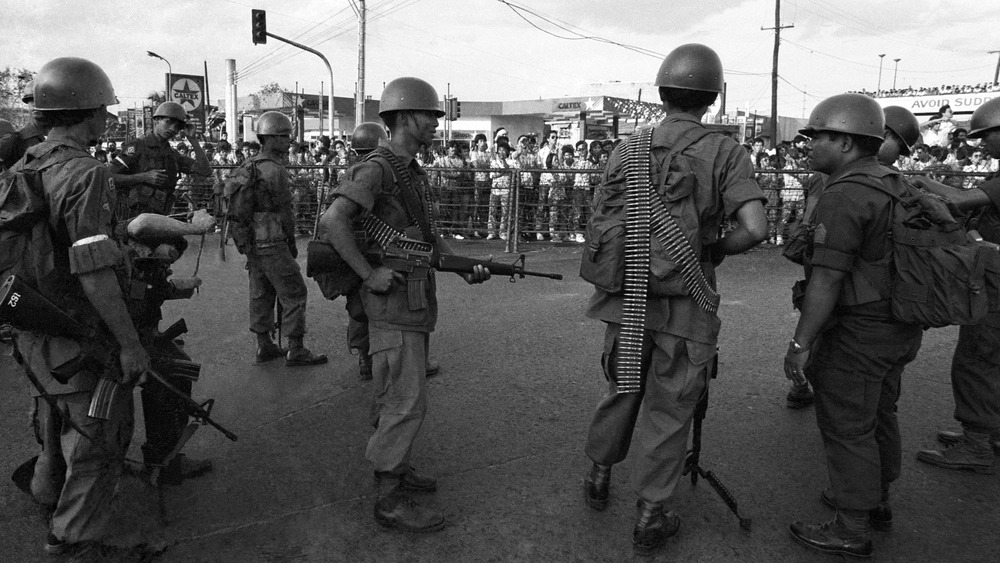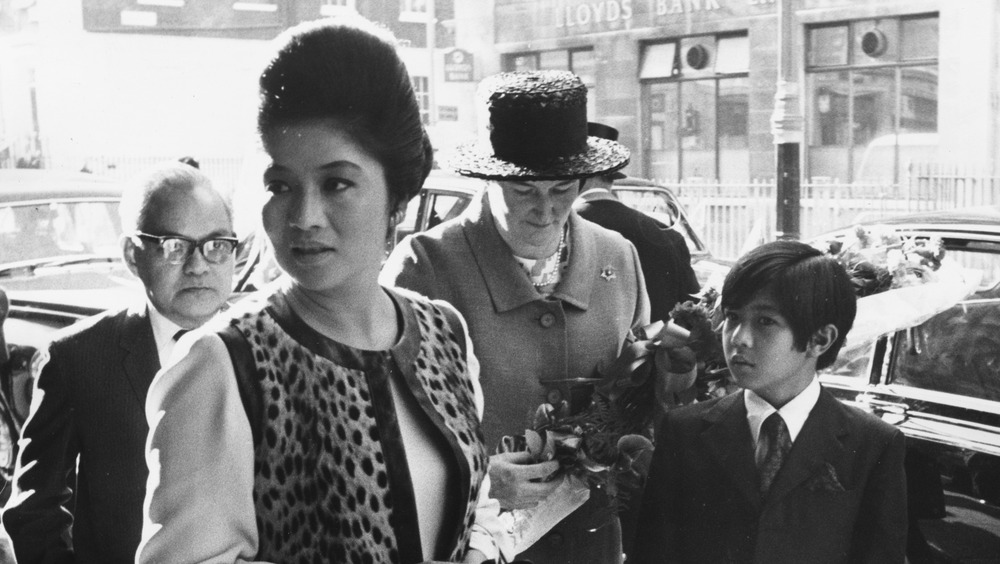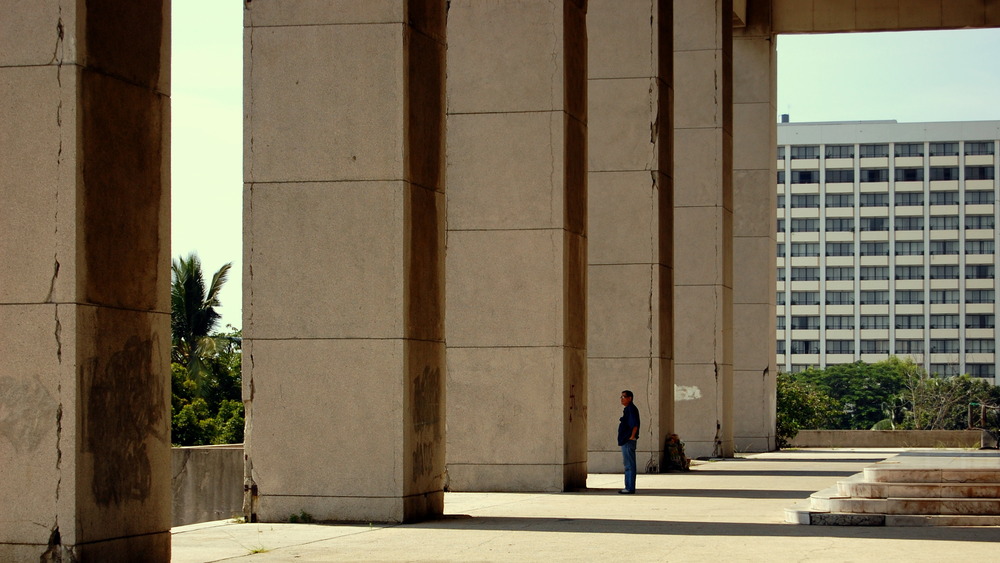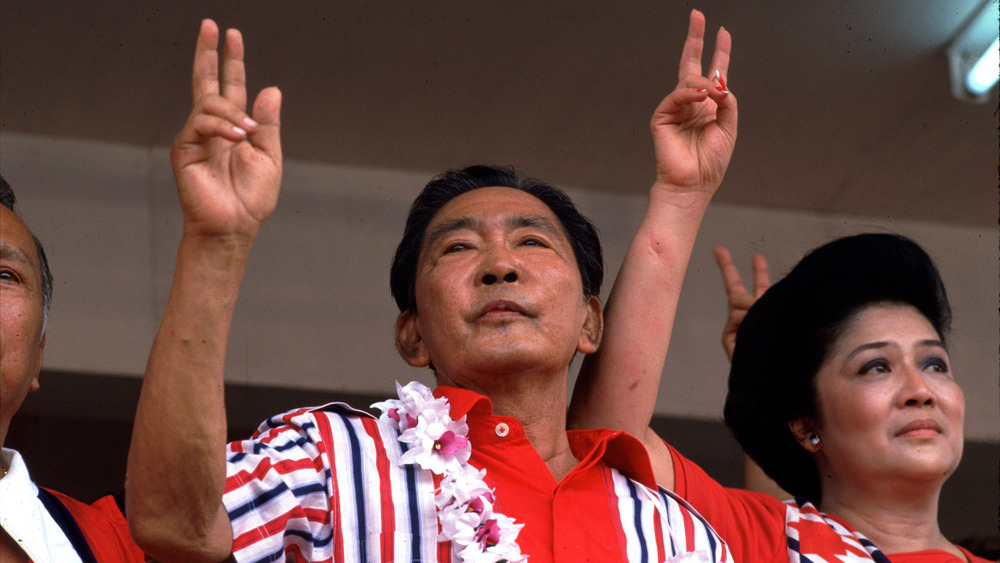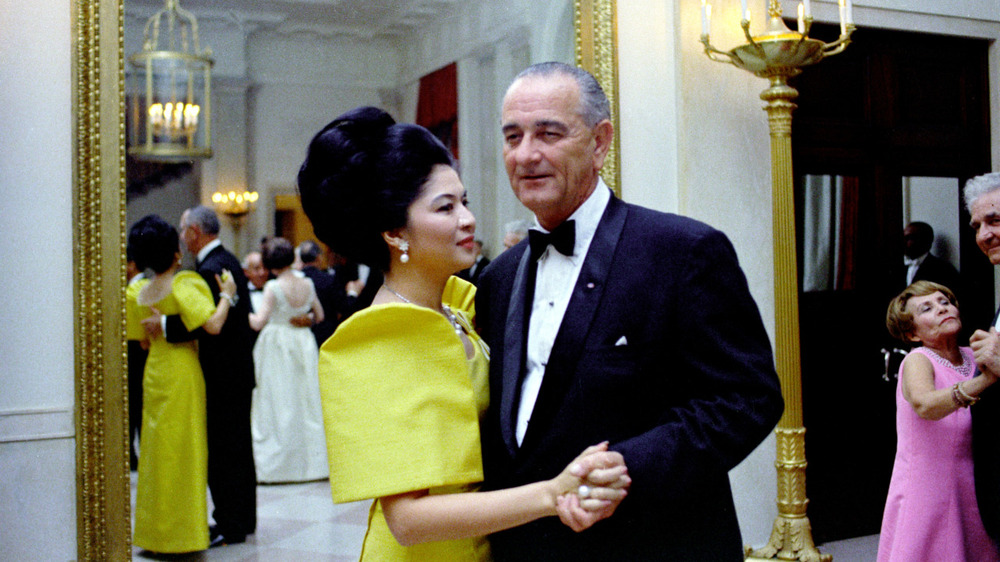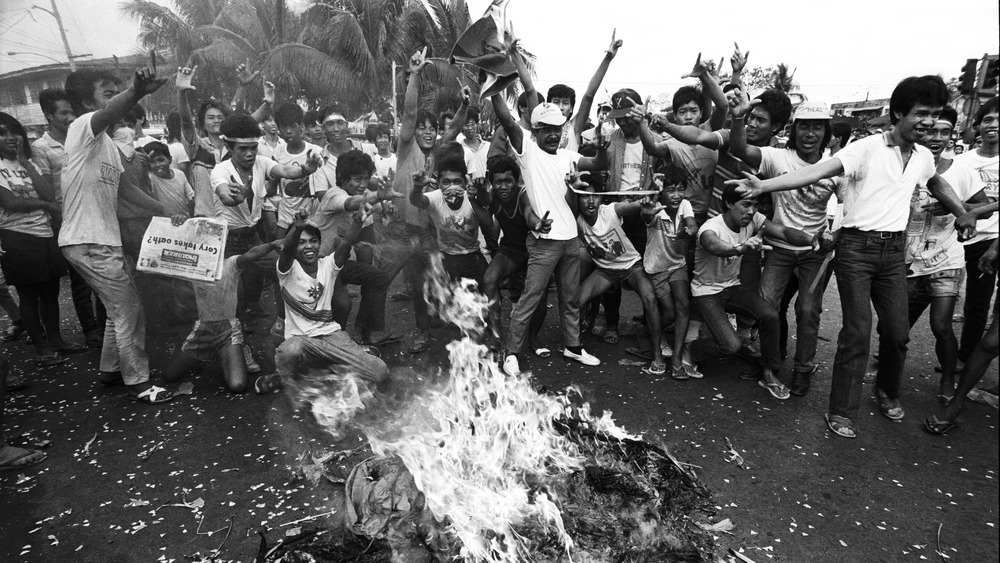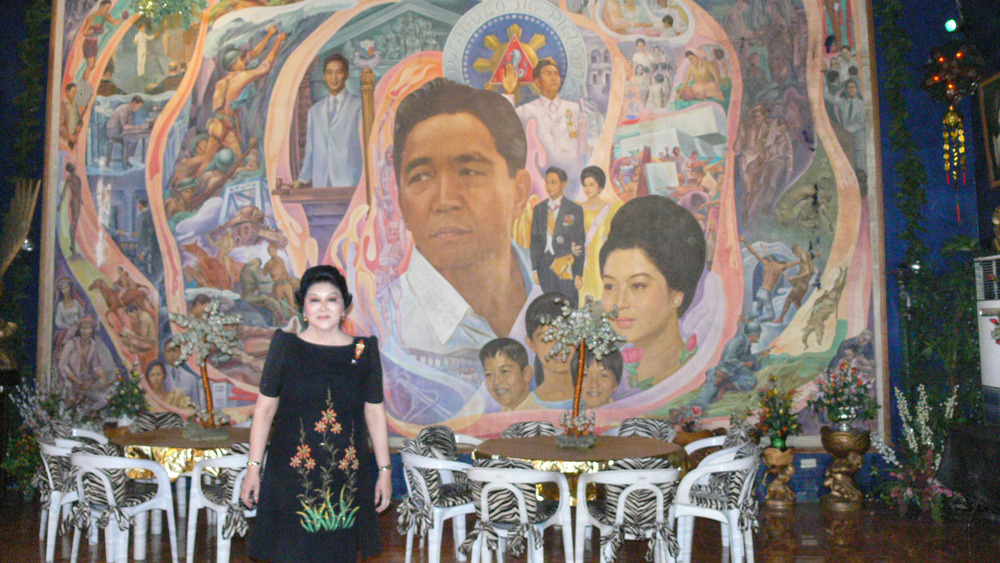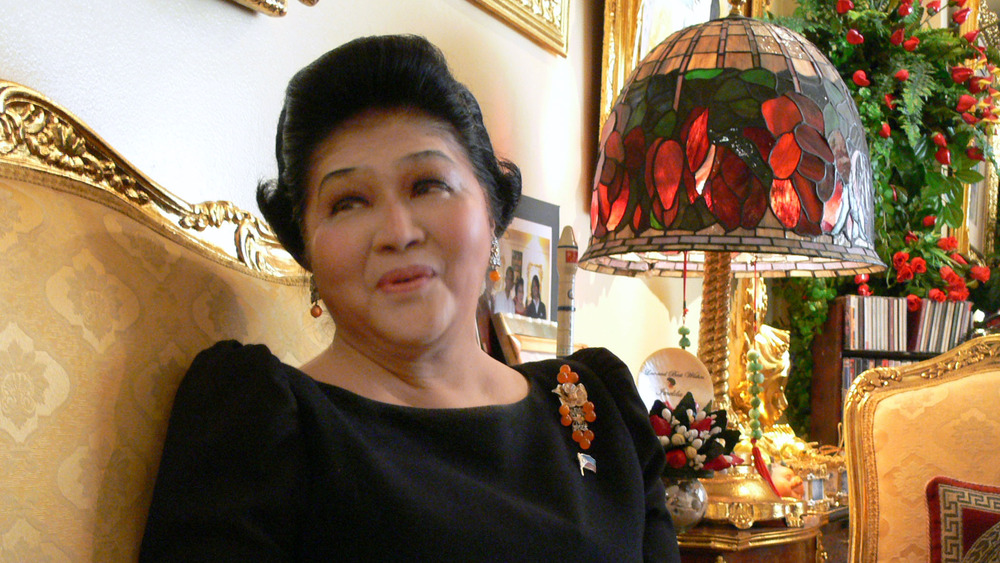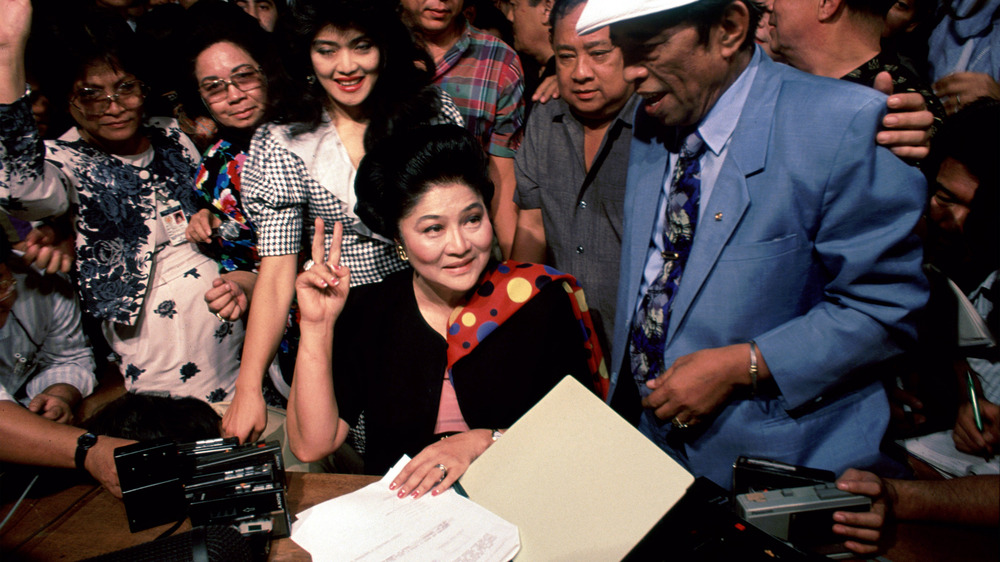The True Story Of The Woman Who Stole Billions From The Philippines
Despite the fact that the reign of Imelda Marcos and her husband Ferdinand was marked by brutality and corruption, even after being exiled Imelda Marcos was able to return to her normal life in the Philippines. While many know her for her obsession with luxury and her extravagance, her mountain of shoes is only the tip of the iceberg.
While Ferdinand was president of the Philippines, the Marcos family stole roughly $10 billion from the country. During their rule, human rights abuses were also rampant. Tens of thousands of people were imprisoned and tortured. In 2019, some of the victims started to receive compensation as the paintings that were seized from the Marcoses were sold.
Despite numerous high-profile court cases aimed at returning some of their ill-gotten wealth, the convictions have been repeatedly dismissed and as of 2021, Imelda Marcos and her son maintain a prominent position in Philippine politics. This is the true story of the woman who stole billions from the Philippines.
Imelda Marcos' early life
Imelda Marcos was born Imelda Remedios Visitacion Romuáldez in Manila, Philippines on July 2nd, 1929. Biography writes that her father, Vicente Orestes Romuáldez, was a lawyer and her mother, Remedios T. Romuáldez, was a homemaker, but her mother died of pneumonia when Marcos was only 8-years-old. Around the same time, her father's law practice fell onto hard times, which led him to move his family to Tacloban in the Leyte province.
Imelda had several older half-siblings from her father's side and she had five younger siblings as well. In Tacloban, "the family continued to struggle financially." However, Imelda was able to receive her schooling at an all-girls school, Holy Infant Academy, and later received a bachelor's degree in education from St. Paul's College, according to The Famous People.
Despite her own family's financially precarious situation, the Romuáldez clan was politically prominent and while she was in school, Imelda lived with a wealthy uncle. However, the Los Angeles Times reports that "she had to share a room with the housekeeper and was excluded from the family's inner circle."
Meanwhile, Imelda started entering beauty pageants as a teenager and when she was 18-years-old, she was crowned Rose of Tacloban.
Imelda meets Ferdinand Marcos
Imelda moved back to Manila when she was in her 20s, and it was around this time that she met Ferdinand Emmanuel Edralin Marcos, Sr. The Washington Post writes that Imelda was working in a music store when she was introduced to Ferdinand, at that time "an ambitious young congressman." According to PBS, they met "in the Congressional cafeteria."
But regardless of how they met, everyone agrees that 11 days later they were married. Imelda once joked that she "wished he would have courted me longer." But Imelda also recalls that the majority opinion at the time was "whoever will not marry this guy is stupid," so she thought there wasn't much time to waste.
However, it's not unlikely that they had each other in their lines of site, since Imelda had appeared on a number of magazine covers and had even been named "Muse of Manila" by the mayor around the same time that she met Ferdinand.
Eyes on the presidency
After they were married, Imelda Marcos had three children before taking an active role in her husband's political career. From 1960 to 1965, she met politicians around the country to acquaint herself with those who could help her husband rise to power. And in 1965, Ferdinand was elected President of the Philippines.
While her husband was president, Imelda became an incredibly prominent first lady. She became known for her travels around the world, meeting a number of world leaders, ranging from Libya's Muammar al-Qaddafi to Cuba's Fidel Castro. PBS writes that Imelda Marcos would go on to establish a number of cultural projects, and at one point even served as the governor of Metro Manila, appointed by her husband in 1975, during which she focused her efforts primarily on the "beautification" of the city.
Imelda and Ferdinand tried to cultivate an image akin to that of Jackie and John F. Kennedy, drawing numerous comparisons, and this image was also helpful in cultivating "American approval." But although Imelda Marcos saw herself as a Jackie Kennedy, others likened her to Eva Peron and considered her a similar front for her husband's military regime.
In 1969, Ferdinand was re-elected to a second term as president.
Ruling as a dictatorship
On September 23rd, 1972, Ferdinand declared martial law in the Philippines, giving himself dictatorial powers over the country. Just days before, a protest with over 30,000 members had marched through Plaza Miranda, sponsored by the Concerned Christians for Civil Liberties, but by that point the plans for martial law were already in motion.
After a shooting was staged to justify military rule against a communist threat, the Philippines fell into 14 years of dictatorship under the Marcoses. According to Rappler, although Ferdinand technically ended martial law in 1981, democracy in the country wouldn't be fully restored until the Marcos family was overthrown in 1986. According to The Irish Times, during their reign the couple earned the title of the "conjugal dictatorship."
Under the military rule, a curfew was enforced, private media facilities were closed down, and assembling in a group was forbidden. Anyone who was considered a threat to Marcos' family rule was arrested and detained. It's estimated that upwards of 70,000 people were imprisoned, at least half were tortured, and over 3,000 were murdered. Although there are claims that Imelda and Ferdinand made good investments into the country's infrastructure during these years, many allege that "it took the country an entire generation to recover from the bad outcomes of the Marcos regime's economic policies and management."
Living lavishly
Although the official salary of the president never went above $13,500 a year, it's estimated that the Marcoses amassed up to $10 billion while Ferdinand was in office. And they didn't refrain from flaunting their wealth in "a nation in which 40 percent of the people survive on less than $2 a day."
Imelda Marcos was known for her immense shoe collection, which numbered over 1,000 pairs. According to The Guardian, after the couple was driven out during the 1986 revolt, "the new president Corazon Aquino had Imelda Marcos' shoes displayed at the presidential palace as a symbol of the former first lady's lavish lifestyle." She was known for her extensive shopping habits, and she'd often fly to places like New York City to buy high-end items.
Imelda's lavish spending knew no bounds. When she bought perfume, she bought it by the gallon. At one point, she even tried to buy Tiffany & Co. And in Thirty Years Later, Myles Garcia writes that there's also evidence that Imelda tried to buy the Pan Am Building on Park Avenue "in cash."
Displacing an indigenous population
In 1976, Imelda Marcos decided to turn Calauit Island into a safari park, complete with animals imported from Kenya. And in doing so, at least 200 Tagbanwa people who lived on the island were displaced to make room for the animals. "It was a strange, unnatural Jurassic Park," writes The Guardian, complete with zebras, giraffes, impalas, and wild boars. There are some reports that the Marcos family used the island as an exotic hunting ground.
Meanwhile, the Tagbanwas were deported to Halsey Island, "a former leper colony in the US," according to Nolisoli. Some Tagbanwas were able to return in the 1990s, and in 2010 the government awarded the Tagbanwa "an ancestral domain title over the land and the surrounding sea," writes Philippine Daily Inquirer.
However, now back on the island there are frequent battles over resources between native humans and displaced animals, especially after natural disasters such as typhoons. The animals themselves are also thought to be suffering from inbreeding and many question whether or not the existence of the animals on that island should be maintained. At least now, the Tagbanwas technically have some say in the future of their land.
The show must go on
In 1981, Imelda Marcos decided that she wanted the Philippines to be the film capital of the world, and she approved plans for the Manila Film Center, which she expected to become the "Cannes of Asia." Instead, it became a horrific metaphor for how hollow the Marcos regime truly was. Culture Trip writes that workers were given less than three months to construct the Manila Film Center and as delays started to add up, construction was pushed through at all costs, with people working literally around the clock. The center was meant to open on January 18th, 1982 for the Manila International Film Festival, and everything was rushed. The grand lobby, which required six weeks of construction, was scrambled together in 72 hours. According to Esquire, "around 4,000 laborers were hired and they rotated among three shifts across 24 hours."
Then, disaster struck on November 17th, 1981, when scaffolding collapsed and workers became trapped in quick-drying cement. Imelda Marcos was informed of the accident, and in response "she ordered the construction to continue as planned and that the bodies – maybe as many as 169 – be covered with cement." It's unclear how many were buried alive.
Media wasn't allowed onto the scene until 10 hours after the accident, and due to the media blackout during the martial law, it's impossible to know the full extent of the accident. And despite everything, the film festival went on as planned in January, but it only lasted two years.
The Marcos' political crimes
Most of Ferdinand Marcos' career was based around using money to buy power, even before he became president. The presidency just helped him expand his reach. The Guardian writes that "with sacks of cash from rich backers and help from the CIA, the bright young lawyer won elections to congress, then the senate, but he was nothing special, just another 'Mr. Ten Per Cent' selling his political influence. After he became President Ten Per Cent in 1965, his income from kickbacks for government contracts increased." The imposition of martial law later helped Ferdinand legally expand his control. According to Rappler, many of these presidential decrees plainly "granted special privileges to his cronies" as he siphoned wealth out of various industries.
Meanwhile, Imelda Marcos was essentially acting as the vice president during her numerous travels and meetings with heads of state, even as the position was abolished during martial law. And after the imposition of martial law, she gladly took on the political posts given to her by her husband, including the governorship. She even served as the Minister of Human Settlements and Ecology.
And Imelda was well aware of the influence she and her husband had. According to Inquirer, in 1998, she declared during an interview, "we practically own everything in the Philippines—from electricity, telecommunications, airline, banking, beer and tobacco, newspaper publishing, television stations, shipping, oil and mining, hotels and beach resorts, down to coconut milling, small farms, real estate, and insurance."
The Marcos' financial crimes
When the Marcoses came into power with the presidency, their net worth was approximately $7,000. When they were forced to flee and exile themselves in Hawaii, their assets totaled $5 billion, though other estimates put the number as high as $10 billion. "Controlling corruption by heads of government and political elites" explains that they amassed that fortune largely through "an extensive and complex system of laundering monies through Swiss and offshore banks." They frequently used secret names and layers upon layers of companies and foundations in order to mask their activities. And the Swiss banks were more than accommodating, helping Imelda and Ferdinand hide their assets using Swiss lawyers as a front.
Rappler writes that in 1990, the Swiss Federal Supreme Court confirmed the fact that the Marcoses hid at least $65 million in Swiss banks. And from 1986 to 2015, the Presidential Commission on Good Governance worked on recovering some of the money that the Marcoses had amassed. Over the course of almost 20 years, they recovered more than $3 billion.
The fact that the Marcoses were robbing the country didn't go unnoticed, but numerous countries declined to intervene. The CIA was well-aware of all the wealth that the Marcoses had stolen, even before Ferdinand was deposed. The United Kingdom was also aware, and Margaret Thatcher's government simply claimed that it was "not our business."
The People Power Revolution
In 1985, Ferdinand Marcos was pressed on whether or not he was going to hold snap elections, and everyone was stunned when he said he would. Positively Filipino writes that Imelda Marcos was abroad at the time, and although she publicly claimed that she knew all about his decision, "her close associates noted how upset she was about the announcement."
The snap elections were held 60 days after the announcement. Ferdinand timed it deliberately in order to keep the opposition from having the opportunity to unite behind a candidate. The Presidential Museum & Library writes that "massive poll fraud and rampant cheating marred the vote, with the Batasang Pambansa proclaiming Marcos the winner" despite the fact that some polls showed Corazon C. Aquino with 70 percent of the votes.
After Ferdinand declared himself the winner of the snap elections on February 20th, 1986, Aquino led a protest and called for civil disobedience and boycotts. Up to two million people showed up to the rally, and as protests swelled over the course of several days, on February 25th, two inaugurations were held as Aquino and Marcos were both sworn in as president. Ferdinand reinstated martial law, but it was clear that his reign was coming to an end.
Exile in Hawaii
Despite trying to cling to power and holding his own inauguration, by the evening of February 25th it was clear to Ferdinand Marcos that the presidency was lost. The New York Times reports that although he "made no public resignation when he departed, the United States immediately recognized [Aquino's] administration."
Traveling to Hawaii via Guam with the help of the United States, the Marcoses began their life of exile, though they definitely didn't leave their life of luxury behind. According to The Guardian, the official U.S. customs record of what they brought is 23 pages long: "In the two C-141 transport planes that carried them, they had packed: 23 wooden crates; 12 suitcases and bags, and various boxes, whose contents included enough clothes to fill 67 racks; 413 pieces of jewelry, including 70 pairs of jewel-studded cufflinks; an ivory statue of the infant Jesus with a silver mantle and a diamond necklace; 24 gold bricks, inscribed 'To my husband on our 24th anniversary;' and more than 27m Philippine pesos in freshly-printed notes. The total value was $15m."
ABC writes that in 1990, Imelda Marcos was put on trial in New York for racketeering, but she was acquitted.
Imelda Marcos returns to the Philippines
After Ferdinand Marcos died in September 1989, Imelda Marcos decided to return to the Philippines, claiming to be "a poor widow who knew nothing about her husband's activities." Since then, Imelda has often been involved in lawsuits and faced convictions. She was arrested soon after returning, but she was released on bail. In 1993, she was convicted of defrauding the state in a land deal, but her case was thrown out "on technical grounds," according to The Guardian.
In December 1989, a court in Seattle found the Marcoses guilty of being part of a plot to murder two Filipino union activists. And six years later, a court in Hawaii found the Marcos regime guilty of human rights abuses. The Marcos' estate was ordered to pay compensation in both cases, but almost none of it had been paid as of 2016.
Ignoring her legal problems, Imelda wasted no time in stepping back into the political scene when she returned to the Philippines. Between 1995 and 2016, she was elected as a congresswoman four times, writes Town and Country Magazine. She makes two unsuccessful runs for president as well. While her final term in Congress ended in 2019, her family still holds political sway in the Philippines, and her son Ferdinand "Bongbong" Marcos, Jr. is considered by many to be "the natural successor to President Duterte."
Trial and trial again
In 2018, Imelda Marcos found guilty on seven counts of corruption. According to The New York Times, the charges were initially filed in 1991, but the hearings were repeatedly delayed by Marcos' lawyers. While this wasn't her first conviction, was unclear if her sentence would ever be carried out. It was also unclear what Marcos thought of her trial, since she declined to make an appearance while it was underway. She also wasn't there during her sentencing, and The Guardian writes that a warrant was issued for her arrest. However, Marcos posted bail and appealed the ruling. SCMP reports that in 2019, President Rodrigo Duterte also approved a public auction of Marcos' jewelry, which is estimated to be worth over $19 million.
Despite everything, Imelda Marcos has always maintained her innocence: "My conscience is clear. If I were corrupt, it would show on my face."
In 2019, the case was thrown out by a Philippine court.
